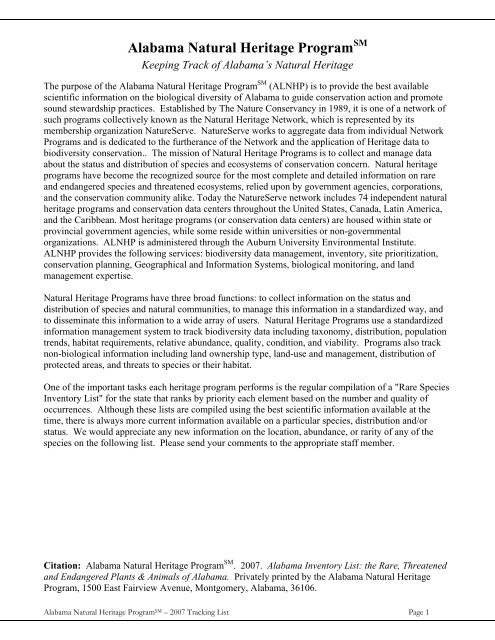Alabama Inventory List- The Rare, Threatened, and Endangered ...
Alabama Inventory List- The Rare, Threatened, and Endangered ...
Alabama Inventory List- The Rare, Threatened, and Endangered ...
Create successful ePaper yourself
Turn your PDF publications into a flip-book with our unique Google optimized e-Paper software.
<strong>Alabama</strong> Natural Heritage Program SM<br />
Keeping Track of <strong>Alabama</strong>’s Natural Heritage<br />
<strong>The</strong> purpose of the <strong>Alabama</strong> Natural Heritage Program SM (ALNHP) is to provide the best available<br />
scientific information on the biological diversity of <strong>Alabama</strong> to guide conservation action <strong>and</strong> promote<br />
sound stewardship practices. Established by <strong>The</strong> Nature Conservancy in 1989, it is one of a network of<br />
such programs collectively known as the Natural Heritage Network, which is represented by its<br />
membership organization NatureServe. NatureServe works to aggregate data from individual Network<br />
Programs <strong>and</strong> is dedicated to the furtherance of the Network <strong>and</strong> the application of Heritage data to<br />
biodiversity conservation.. <strong>The</strong> mission of Natural Heritage Programs is to collect <strong>and</strong> manage data<br />
about the status <strong>and</strong> distribution of species <strong>and</strong> ecosystems of conservation concern. Natural heritage<br />
programs have become the recognized source for the most complete <strong>and</strong> detailed information on rare<br />
<strong>and</strong> endangered species <strong>and</strong> threatened ecosystems, relied upon by government agencies, corporations,<br />
<strong>and</strong> the conservation community alike. Today the NatureServe network includes 74 independent natural<br />
heritage programs <strong>and</strong> conservation data centers throughout the United States, Canada, Latin America,<br />
<strong>and</strong> the Caribbean. Most heritage programs (or conservation data centers) are housed within state or<br />
provincial government agencies, while some reside within universities or non-governmental<br />
organizations. ALNHP is administered through the Auburn University Environmental Institute.<br />
ALNHP provides the following services: biodiversity data management, inventory, site prioritization,<br />
conservation planning, Geographical <strong>and</strong> Information Systems, biological monitoring, <strong>and</strong> l<strong>and</strong><br />
management expertise.<br />
Natural Heritage Programs have three broad functions: to collect information on the status <strong>and</strong><br />
distribution of species <strong>and</strong> natural communities, to manage this information in a st<strong>and</strong>ardized way, <strong>and</strong><br />
to disseminate this information to a wide array of users. Natural Heritage Programs use a st<strong>and</strong>ardized<br />
information management system to track biodiversity data including taxonomy, distribution, population<br />
trends, habitat requirements, relative abundance, quality, condition, <strong>and</strong> viability. Programs also track<br />
non-biological information including l<strong>and</strong> ownership type, l<strong>and</strong>-use <strong>and</strong> management, distribution of<br />
protected areas, <strong>and</strong> threats to species or their habitat.<br />
One of the important tasks each heritage program performs is the regular compilation of a "<strong>Rare</strong> Species<br />
<strong>Inventory</strong> <strong>List</strong>" for the state that ranks by priority each element based on the number <strong>and</strong> quality of<br />
occurrences. Although these lists are compiled using the best scientific information available at the<br />
time, there is always more current information available on a particular species, distribution <strong>and</strong>/or<br />
status. We would appreciate any new information on the location, abundance, or rarity of any of the<br />
species on the following list. Please send your comments to the appropriate staff member.<br />
Citation: <strong>Alabama</strong> Natural Heritage Program SM . 2007. <strong>Alabama</strong> <strong>Inventory</strong> <strong>List</strong>: the <strong>Rare</strong>, <strong>Threatened</strong><br />
<strong>and</strong> <strong>Endangered</strong> Plants & Animals of <strong>Alabama</strong>. Privately printed by the <strong>Alabama</strong> Natural Heritage<br />
Program, 1500 East Fairview Avenue, Montgomery, <strong>Alabama</strong>, 36106.<br />
<strong>Alabama</strong> Natural Heritage Program SM – 2007 Tracking <strong>List</strong> Page 1

















